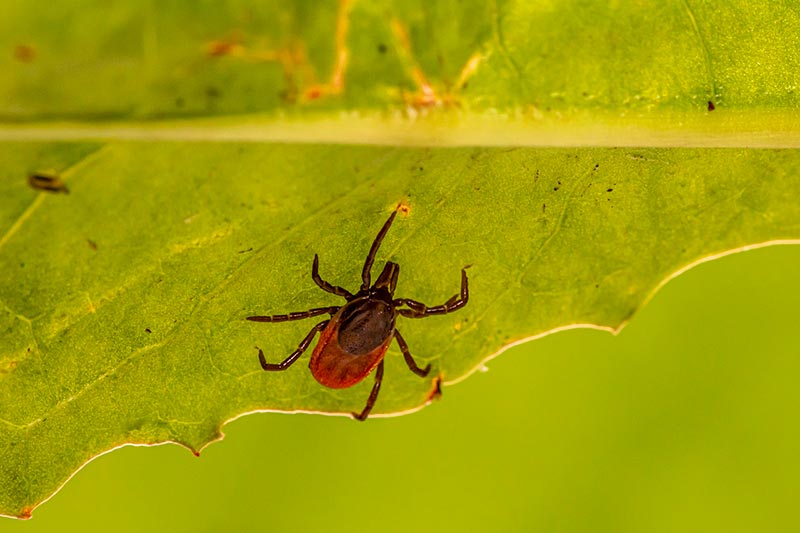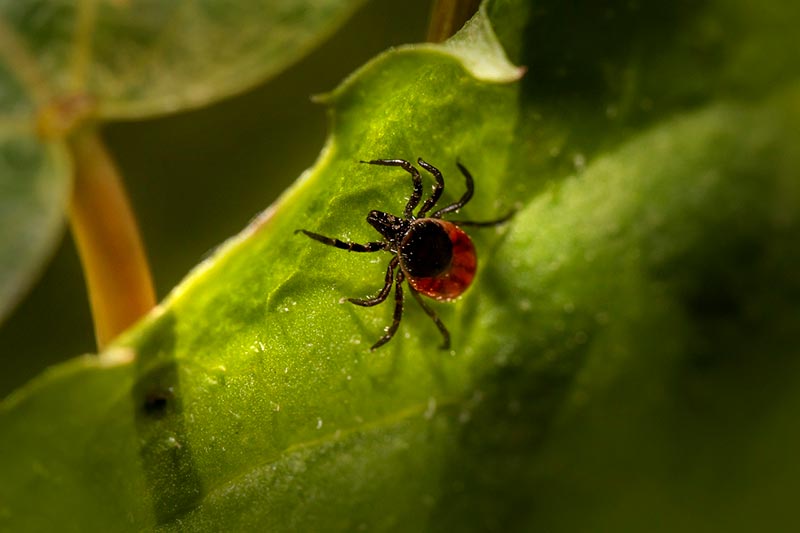4 Types of Ticks in Canada (With Pictures)
-

- Last updated:

There are over 850 species of ticks worldwide. About 40 of these species can be found in Canada, but only a few varieties explore habitats outside tall grasses and wooded areas. These blood-sucking parasites can enter your home while latched to your furry friend.
Families have reason to worry following a recent Canadian Veterinary Medical Association study. The report shows ticks are undergoing range expansions across Canada because of land fragmentation and global warming. They are estimated to have a range expansion of roughly 46 kilometers annually!
Ticks can cause life-threatening diseases, like Lyme disease, tick-borne relapsing fever, ehrlichiosis, and tularemia. Today, we will analyze the common types of ticks in Canada. We will also let you in on their appearance, preferred habitat, and the dangers they pose.
The 4 Types of Ticks in Canada
1. Black-Legged Tick

| Body Color: | Red-orange with black shield |
| Legs: | Dark Black |
| Preferred Habitat: | Deciduous Forests |
The Black-legged tick, also known as the deer tick, is quite common in Canada. It has a red-orange body with a black shield or scutum (hardened plate on the dorsal surface). The tick also has dark black legs; hence the name “black-legged” tick.
The black-legged tick is one of the deadliest ticks worldwide because it transmits B. mayonii and Borrelia burgdorferi. These are two bacteria infamous for causing Lyme disease. Other diseases the arachnid spreads include relapsing fever, Borreliosis, Powassan virus, ehrlichiosis, babesiosis, and anaplasmosis.
Preferred Habitat
As black-legged ticks spread, their preferred habitat is now not restricted to deciduous forests. While the arachnid prefers deer hosts, it can also latch on birds, squirrels, mice, and livestock. The ticks can also bite humans roaming outdoors who are in contact with bushes, grass, and pets.
2. American Dog Tick

| Body Color: | Dark brown with off-white or mottled gray scutum |
| Legs: | Dark brown |
| Preferred Habitat: | Grassy fields |
Another common type of tick in Canada is the American dog tick. It has a dark brown body and legs. While females have an off-white section on their shields, the scutum of males has gray markings on their scutum. These ticks have oval, flattened bodies and can range between 5 mm and 15 mm in size, depending on whether they have fed.
An American dog tick bite can expose you to diseases like Rocky Mountain spotted fever, Anaplasma, Tularemia, and Ehrlichia. The tick can also cause tick paralysis, especially if it bites a child under eight years old. You must seek immediate medical attention if you suspect being bitten by an American dog tick.
Preferred Habitat
The preferred habitat of the American dog tick is in properties with grassy fields and low-lying bushes. Your property can be extra attractive to the ticks, especially if you have outdoor pets or other animals that frequent your yard. You can also find these ticks on potted plants and gardens if you have an infestation.
3. Rocky Mountain Wood Tick
| Body Color: | Reddish brown |
| Legs: | Reddish brown |
| Preferred Habitat: | Wooded sites with low-growing vegetation |
The Rocky Mountain wood ticks have physical similarities with the American dog ticks. They have reddish brown bodies, although their bodies are teardrop shaped. While females have white-hued shields, the males have white and gray spots on their bodies.
Also, they differ from American dog ticks in that their peak season is between January and November, and they are less active in summer.
When a Rocky Mountain wood tick bites you, its toxin can take up to 72 hours to dispel after you have removed the parasite. This tick’s saliva contains a neurotoxin capable of causing tick paralysis in pets and humans.
Other diseases spread by the Rocky Mountain wood tick include Q fever, tularemia, Colorado tick fever, and Rocky Mountain spotted fever.
Preferred Habitat
Rocky Mountain wood ticks prefer dwelling in mountainous areas. They are quite prevalent in Southwestern Canada in sites with elevations of 4,000 to 10,500 feet. Generally, they live in lightly wooded areas, scrublands, and open grasslands with low-growing vegetation.
4. Brown Dog Tick
| Body Color: | Reddish brown |
| Legs: | Reddish brown |
| Preferred Habitat: | Indoors or outdoors |
The brown dog tick also has a reddish brown body, although it has a narrower shape than most ticks. When engorged, the tick’s body turns olive or gray-blue. Males have small pits on their backs, and their shields cover their entire bodies. Females also have shields, although they only cover the front half of their backs.
Brown dog ticks seldom bite humans, although they can if they cannot locate a canine host. They are more likely to infest your home because they can live indoors or outdoors. Infestations often begin when a dog carries the ticks from other sites like dog kennels, grooming facilities, dog parks, or infested homes. A bite from the brown dog tick can expose you to Rocky Mountain spotted fever.
Preferred Habitat
As the name suggests, dogs are the preferred hosts of brown dog ticks. This makes this creepy crawly more widespread in Canada and worldwide. Any location with a dog is a perfect habitat for the brown dog tick. The parasite can even set shop in your home and thrive through an entire life cycle that involves laying eggs.
Tips to Prevent Tick Infestation
Ticks feed on blood from animals and humans. It is crucial to beware of the risk of tick bites, especially during the peak tick seasons in spring and summer. Fortunately, ticks can only crawl and cannot fly or jump. Their mobility limitations make it easier to prevent infestations using a few simple tricks.
- Vacuum and clean your home regularly
- Use tick shampoo on pets
- Keep your grass mowed and clear out leaf litter
- Trim tree branches
- Use a tick insecticide on your garden
- Create a tick barrier between your yard and nearby woodland areas
- Manage pet activity, especially in tick-prone habitats
- Apply tick repellent when entering tick-prone zones, and
- Wear proper footwear, a long-sleeved shirt, and tucked-in pants
- Do a full-body check before entering your home
Conclusion
A tick storm has been brewing over the past few decades because of human and environmental factors. Unfortunately, Canada has experienced an explosion of these pests, making it crucial to take action if you suspect you have been bitten by a tick.
We hope you are now well-informed about the four common types of ticks found in Canada, the diseases they spread, and how to prevent an infestation. Investing in professional pest control services is imperative if you have a serious invasion in your home or property.
- https://ncceh.ca/documents/evidence-review/review-ticks-canada-and-health-risks-exposure
- https://atlantic.ctvnews.ca/experts-expect-bad-year-for-ticks-as-disease-carrying-bugs-expand-range-in-canada-1.5927273
- https://ipac-canada.org/lyme-disease
- https://www.canada.ca/en/public-health/services/laboratory-biosafety-biosecurity/pathogen-safety-data-sheets-risk-assessment/rickettsia-rickettsii.html
Featured Image Credit: Erik_Karits, Pixabay
Contents


